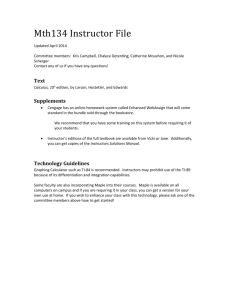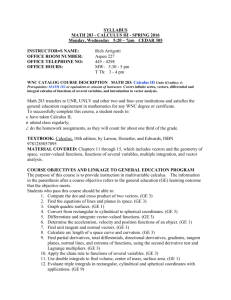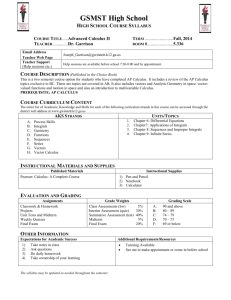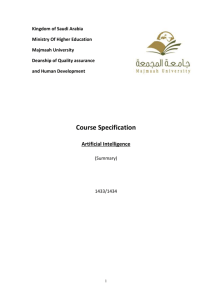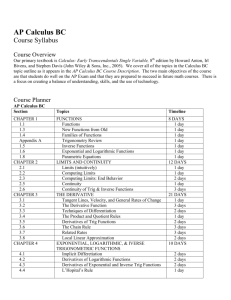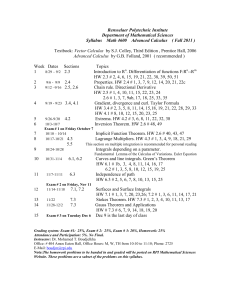Mathematics 204 A ( Elementary Calculus II) Course Outline Winter
advertisement
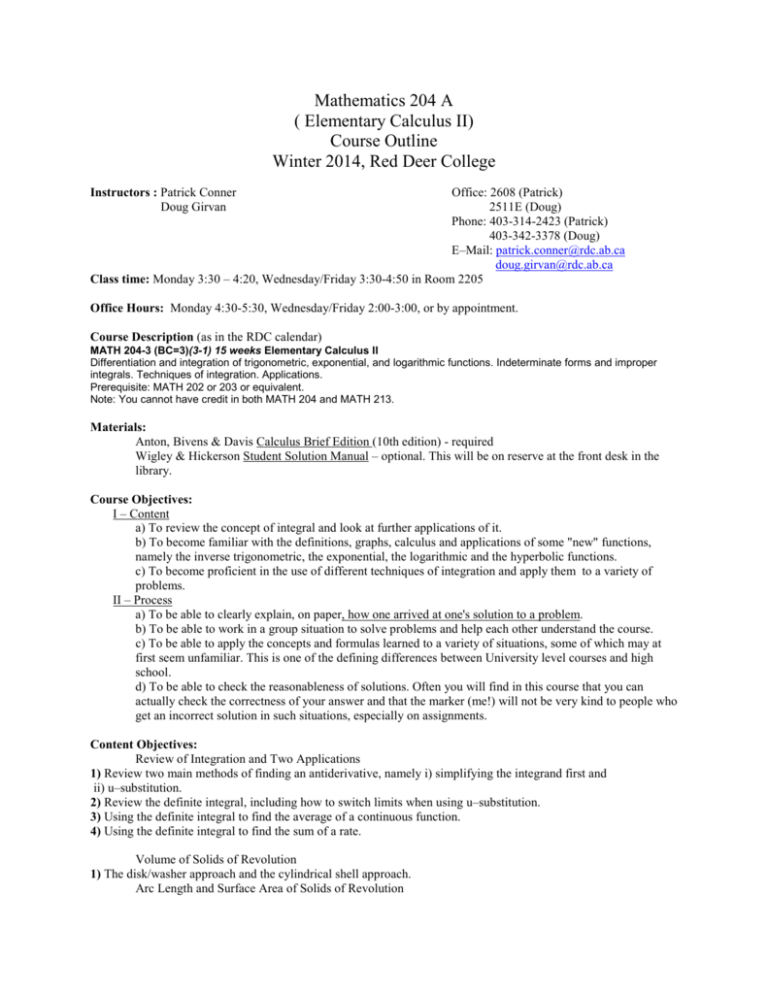
Mathematics 204 A ( Elementary Calculus II) Course Outline Winter 2014, Red Deer College Instructors : Patrick Conner Doug Girvan Office: 2608 (Patrick) 2511E (Doug) Phone: 403-314-2423 (Patrick) 403-342-3378 (Doug) E–Mail: patrick.conner@rdc.ab.ca doug.girvan@rdc.ab.ca Class time: Monday 3:30 – 4:20, Wednesday/Friday 3:30-4:50 in Room 2205 Office Hours: Monday 4:30-5:30, Wednesday/Friday 2:00-3:00, or by appointment. Course Description (as in the RDC calendar) MATH 204-3 (BC=3)(3-1) 15 weeks Elementary Calculus II Differentiation and integration of trigonometric, exponential, and logarithmic functions. Indeterminate forms and improper integrals. Techniques of integration. Applications. Prerequisite: MATH 202 or 203 or equivalent. Note: You cannot have credit in both MATH 204 and MATH 213. Materials: Anton, Bivens & Davis Calculus Brief Edition (10th edition) - required Wigley & Hickerson Student Solution Manual – optional. This will be on reserve at the front desk in the library. Course Objectives: I – Content a) To review the concept of integral and look at further applications of it. b) To become familiar with the definitions, graphs, calculus and applications of some "new" functions, namely the inverse trigonometric, the exponential, the logarithmic and the hyperbolic functions. c) To become proficient in the use of different techniques of integration and apply them to a variety of problems. II – Process a) To be able to clearly explain, on paper, how one arrived at one's solution to a problem. b) To be able to work in a group situation to solve problems and help each other understand the course. c) To be able to apply the concepts and formulas learned to a variety of situations, some of which may at first seem unfamiliar. This is one of the defining differences between University level courses and high school. d) To be able to check the reasonableness of solutions. Often you will find in this course that you can actually check the correctness of your answer and that the marker (me!) will not be very kind to people who get an incorrect solution in such situations, especially on assignments. Content Objectives: Review of Integration and Two Applications 1) Review two main methods of finding an antiderivative, namely i) simplifying the integrand first and ii) u–substitution. 2) Review the definite integral, including how to switch limits when using u–substitution. 3) Using the definite integral to find the average of a continuous function. 4) Using the definite integral to find the sum of a rate. Volume of Solids of Revolution 1) The disk/washer approach and the cylindrical shell approach. Arc Length and Surface Area of Solids of Revolution 1) Development of the integral for arc length and some simple examples. 2) Development of the integral for surface area of a solid of revolution and some examples. Work 1) Using integrals to evaluate work done in selected situations. Introduction to Inverse Functions 1) Algebraic and geometric introduction to inverse functions including notation and the horizontal line test. The natural logarithmic function y = ln(x) 1) Derivatives and integrals of and involving ln(x). The Exponential Function 1) The first definition of ex and its calculus and graphs. 2) Bases other than e i.e., ax and their calculus and graphs. 3) Logarithmic functions for bases other than e i.e., logax and their calculus and graphs. 4) Two other approaches to the definition of the number e. L'Hopital's Rule 1) Review of methods to evaluate limits. 2) Using L'Hopital's Rule to evaluate certain limits. Inverse Trig Functions 1) Definitions of the inverse trig functions including notation and graphs. 2) Derivatives and integrals involving inverse trig functions. Hyperbolic Functions 1) Definitions of the hyperbolic functions including notation and graphs. 2) Calculus of the hyperbolic functions. Methods of Integration 1) Review of integration methods taken so far and some harder examples. (8.1 in text) 2) Integration by parts 3) Integrals involving powers of trig functions. 4) Using the three Pythagorean trig identities to help do certain integrals i.e., trig substitution. 5) Using partial fractions to help integrate certain rational functions. 6) Using tables to help do integrals. Improper Integrals 1) The three types of improper integrals and how to evaluate them. Differential Equations (First Order) 1) An introduction to first order separable differential equations. 2) Using exponential functions to solve the differential equation where the rate of growth is proportional to the amount present. 3) The logistic model of growth (if time). Coverage: Essentially we will cover Chapters 5,6, 7 and 8.1 and 8.2. Throughout the term I will suggest some practice problems from each chapter. Evaluation: Assignments (including lab assignments) Test 1 – (Chapter 5.2–5.6 and 0.4,6.1) about Jan. 27 Test 2 – (rest of Chapter 6) about March 7 Test 3 – (7.1–7.5) about March 31 Final Exam Total 20% 10% 20% 10% 40% 100% a) Take home assignments will be posted on Blackboard approximately every 1-2 weeks. They will be due in class on the date indicated on each assignment. b) The calendar indicates that this class has a one hour lab every week. In the lab I will usually plan to give an in– class assignment that will be due at the end of the lab period. c) The most important thing on tests and assignments is that you it be clear how you arrived at your answer. d) The only legitimate reason for missing an assignment or exam is a valid certificate from a doctor. Even in such cases the student should notify the instructor as soon as possible. e) In order to ensure that all students have access to assignment solutions (see Blackboard) in a timely manner, late assignments will not be accepted. Instead, at the end of the term I will omit each student’s lowest-scoring assignment from his/her final grade. In the event that you are unable to turn in an assignment, you should still attempt to complete it for your own benefit; students can expect that some of the exam questions will be similar to problems seen on the assignments. f) While you are encouraged to collaborate with other students when solving homework problems, you must write up your solutions individually. See below for information regarding plagiarism and academic misconduct. g) While I will provide detailed written feedback when grading certain assignment questions, I may not do this for all of them since full solutions are posted online. You should read all of my comments as well as the solutions. If anything is at all unclear after this, please come and see me! h) At the end of the course students will be ranked according to their percentage mark, calculated by a) above, in the course. Then the instructor will assign the letter grades in the Grading Policy on the College web site, using his experience and judgment and the principle that students who receive approximately the same percentage mark should receive the same letter grade. i) Feedback as to your progress in the course will be given by the date indicated in the calendar. j) Since you have three hours to write the final exam (and lots of time to study for it!) you can expect that it will contain some harder questions than the term tests throughout the year. Assistance: a) Me - my office hours are at the beginning of this outline. If you are unable to meet me then, please make an appointment or drop around and take your chances. Because calculus is such a cumulative subject it is imperative that you seek assistance as soon as a problem arises. When you come for help, please bring your work on the problem you're having trouble with. You can also phone me during my office hours. I will accept questions via email, but depending on the depth of your question I may ask that you just come and see me (math notation can be difficult to express via email). b) Besides me (see above) there will be three other main forms of assisstance i) Peter Bovell will be the Math Tutor and can assist you with University Transfer Math (both half-hour appointments and drop in times). ii) Peer tutors may be available. Here’s what Susan Spenser, the Learning Support Coordinator, recently stated about the procedure to contact a Peer tutor: “Students who would like assistance from a peer tutor can go to the Learning Support desk in the Library (it is located to the side of the main Information desk) and fill out a peer tutor request form with their contact information then drop it off in the box provided. We send an email requesting course information. This also helps us ensure we have the right email address. When we hear back from the student we then make the match with a peer tutor (so long as we have one available) and the peer tutor makes contact with the student to arrange a time to meet.” iii) The Math Learning Centre will be housed in hallway across from Room 2600. It will be staffed by the Math Tutor and other RDC math instructors. c) Library - other calculus books are in the QA303 section of the library while those dealing with high school math are in the QA145 - QA154 section. d) Your text. One source suggests the following sequence when using a math text. - read the text; however, a math text is not like a novel and it should be read with pen and paper handy. First try to understand the main structure of the section i.e. the definitions and theorems. - study the examples first trying to work them out without looking at the solution. - begin the suggested homework problems. e) Each other. Find one or more people to do homework and/or study with. You will find that when one student tries to explain something to another that both gain. Attendance Requirements: Students will be expected to attend every class, Otherwise they are responsible for obtaining the notes, announcements etc. from another student. After they have obtained and studied these notes the instructor will be happy to assist them with that material. Lecture notes will also be made available on Blackboard throughout the term. A Personal Note to the Student: Congratulations!! You've passed your first course in calculus (or good luck in your supplemental!). However, Math 204 is probably tougher than Math 202/Math 203 but now you're tougher too! Math 204 demands a constant effort and you're less likely to have taken the topics in Math 31. Also Math 204 uses more of your high school trigonometry which you may not remember. I will be suggesting that you do a lot of problems from the book - if you can't finish all of them just after we finish the corresponding part of the lectures, go onto the next batch (i.e. keep up) and do the remaining ones when reviewing for an exam. You may have a chance to formally evaluate the course. However, always feel free to make suggestions as to possible changes that would help you learn Math 204 better. Generic Statements & Information Required to be on All Course Outlines • • • It is the student’s responsibility to be familiar with the information contained in the Course Outline and to clarify any areas of concern with the instructor. Students should refer to the Formal and Informal Student Appeal Policies and Standard Practice should they have questions or concerns about the Course Outline that cannot be resolved with the instructor. Please be familiar with what constitutes academic misconduct, as well as the consequences. Plagiarism involves submitting work in a course as if it were the student’s own work. Plagiarism may involve the act of submitting work in which some or all of the phrasing, ideas, or line of reasoning are alleged to be the submitter’s own but in fact were created by someone else. • • • • • The Final Examinations Policy and Practice will be followed with respect to final exams. Please review these documents to ensure you understand the contents and implications of the policy. Attendance may take many forms. Lack of attendance may impact the students’ ability to successfully complete the course. This course may be eligible for Prior Learning Assessment. Students should refer to the RDC College Calendar for a list of excluded courses. Classroom Learning Resources may be available to students in alternate formats. Students should be aware that Personal Counseling, Career, Learning and Disability Services are provided by RDC. Inquire about locations at Information Desk. It is the student’s responsibility to discuss their specific learning needs with the appropriate service provider. Important dates for the 2013 Winter Term at RDC (from college website Dec. 29, 2013) (see the previous pages of this course outline for other dates that are specific to this course) 03 Jan Last Day to Pay Fees for Winter Term 2014 06 Jan First Day of Class for Winter Term 2014 08 Jan Last Day to apply for Winter Term 2014 13 Jan Last Day to apply for supplemental exam for Fall term 2013 Last day to register or add/drop/ to have tuition refunded for Winter Term courses 16 Jan Supplemental Exams written 17 Feb Family Day. College closed. 18-21 Feb Mid-Term Break 03 Mar Mid-term feedback date 04 Mar Emergency Response Day 14 Mar Final examination schedule posted 19 Mar Last day to withdraw from Winter Term courses and receive a WD 09 Apr Last day of classes for Full Year and Winter Term courses 14 Apr First day of final examinations for Winter Term courses 18 Apr Good Friday 2014. College closed. 21 Apr Last day of final examinations for Winter Term courses 23 Apr Deferred exams written 25 Apr Last day for submission of final grades for Fall Term courses 28 Apr Final grades available 07 May Last Day to apply for supplemental exam for Winter 10 May Supplemental Exams for Winter written Changes to the course outline will be made with the consent of the course instructor and students. Changes will be reviewed by the Department Chairperson for consistency with College policies. Chairperson:___________________________________ 3 January 2014 Date:___________________________________


